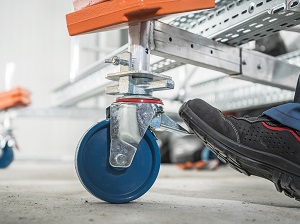Mobile scaffolds can be a safer choice on the job because they allow workers to maintain their balance and work easily from the platform.

Mobile scaffolds are a type of supported scaffold set on wheels or casters. They are designed to be easily moved and are commonly used for things like painting, plastering, drywall installation, or other jobs where workers must frequently change position. Scaffolds can often be a safer choice than ladders.
Narrow frame scaffolds, also known as Baker/Perry style scaffolds, have wheels and are often used as mobile scaffolds with the end frame measuring 3 feet or less in width.
Common hazards that workers must be aware of when using mobile scaffolds include falls from an elevated level, tip-overs, electric shocks, structural failures or collapse, and falling objects.
OSHA Standard 1926 Subpart L provides the construction industry guidelines for Scaffolds. OSHA General Industry Standard 1910.27(a) Scaffolds used in general industry must meet the requirements of the OSHA Construction Standard 1926, Subpart L (Scaffolds).
Conduct a pre-operation inspection to verify that the mobile scaffold is assembled correctly and that all of the scaffold components are functioning properly. Never use a mobile scaffold if it is incomplete, broken, or has missing or ill-fitting parts which need replacement. Before work begins, also assess the work area, the job site conditions, and review the work to be performed.

Even though mobile scaffolds may be smaller than other types of scaffolding systems, falling object protection is still required. To protect employees from falling hand tools, debris, and other small objects, falling object protection is required on or around the scaffold. Heavier objects on the mobile scaffold must be moved away from the edge and secured to prevent falling. Workers on scaffolds must wear hard hats.
OSHA Standard 1926.451(h)(1) In addition to wearing hardhats each employee on a scaffold shall be provided with additional protection from falling hand tools, debris, and other small objects through the installation of toeboards, screens, or guardrail systems, or through the addition of debris nets, catch platforms, or canopy structures that contain or deflect the falling objects.
Keeping the mobile scaffold stable and secure is critically important to worker safety. Mobile scaffolds in use must be plumb, level, and squared. All brace connections must be secured. If the mobile scaffold must be leveled, use screw jacks or the equivalent. Lock scaffold wheels with positive wheel and/or wheel and swivel locks to prevent movement while in use.
OSHA Standard 1926.452(w)(1) Scaffolds shall be braced by cross, horizontal, or diagonal braces, or combination thereof, to prevent racking or collapse of the scaffold and to secure vertical members together laterally so as to automatically square and align the vertical members.
Platforms must not extend outward beyond the base supports of the mobile scaffold unless outrigger frames or equivalent devices are used to ensure stability. If outriggers are installed, deploy installed outriggers on both sides of the scaffold. All locking pins must be engaged before using the scaffold.
Always follow the manufacturer’s allowable load for the casters, scaffold components and platforms, along with recommended bracing to ensure a rigid and structurally sound scaffold.

Power systems used to propel mobile scaffolds must be specifically designed for that use. Do not use a forklift, a truck, other motor vehicles, or an add-on motor to propel a mobile scaffold (unless the scaffold in use is specifically designed for such propulsion systems).
If workers are manually moving the mobile scaffold the force applied should be as close to the base of the scaffold as possible, but definitely not more that 5 feet above the supporting surface.
OSHA Standard 1926.452(w)(5) Scaffolds shall be stabilized to prevent tipping during movement.
The best thing about a mobile scaffold is the versatility and ease of movement. Unlike ladders, mobile scaffolds can be moved while workers are standing on the platform, if the move is conducted safely.
Only move a mobile scaffold if the workers standing on the platform are aware and ready for the movement to happen. When moved, the scaffold must remain on level ground (or within 3 degrees of level) and the area must not have any pits, holes, or obstructions.
If a power system is being used to move the mobile scaffold, the propelling force should be applied directly to the wheels and should not produce a speed in excess of 1 foot per second.
During mobile scaffold movement, no worker can be on any part of the scaffold which extends beyond the wheels, casters, or other supports.
Workers on the mobile scaffold must not attempt to move the scaffold by pulling from one location to another while standing on the platform.
OSHA Standard 1926.452(w)(10) Before a scaffold is moved, each employee on the scaffold shall be made aware of the move.
Do not stand on the guardrail of the mobile scaffold or stand on any other items placed on the scaffold (like stepladders, buckets, boxes, etc.) to gain additional height.
As much as possible, keep the mobile scaffold platform free from tripping hazards like hand tools, equipment, and extra materials.
Use guardrails which include top rails, midrails, and toe boards, or fall protection at working mobile scaffold platform heights of 10 feet or higher.
Stay at least 10 feet away from energized power lines when using mobile scaffolds.


